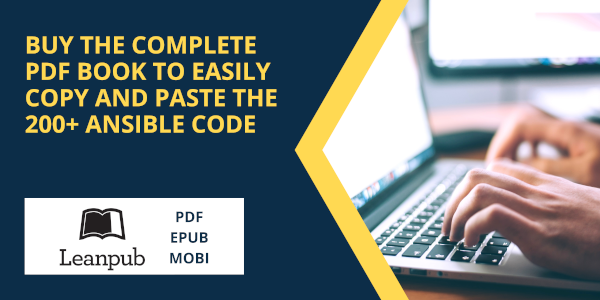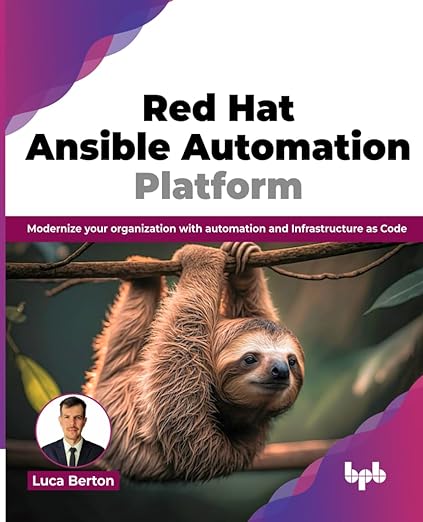Luca's Blog
Red Hat Ansible Automation Platform book by Luca Berton published by BPB Online book
[Red Hat Ansible Automation Platform book by Luca Berton published by BPB Online book]https://amzn.to/41K0cbm) book, authored by Luca Berton, and published by BPB Online was released on 28th December 2023 in the best libraries and online bookshops.
Introduction
Ansible Automation Platform provides an enterprise framework for building and operating IT automation at scale, from security and networking to operations and software development teams.
In the fast-paced world of IT, where agility, scalability, and reliability are non-negotiable, automation has emerged as a cornerstone for efficient data center management. Luca Berton’s book, “Mastering Automation: A Guide to the Ansible Automation Platform,” serves as an indispensable companion for those navigating the complexities of modern IT environments. This comprehensive guide empowers both beginners and seasoned professionals to harness the full potential of the Ansible Automation Platform, a versatile solution for streamlining operations, enhancing deployment processes, and automating critical tasks.
Author Bio
Luca Berton is an Ansible Automation Expert. He has been working for the Red Hat Engineer Team for three years. With more than 15 years of experience as a System Administrator, he has strong expertise in Infrastructure Hardening and Automation. Enthusiast of the Open Source supports the community sharing his knowledge in different events of public access.
Promise of the Book
Embark on a journey to modernize your data center through Infrastructure as Code and Automation. This book guides you to mastering the Red Hat Ansible Automation Platform, enabling you to streamline processes, enhance security, and boost efficiency across your entire IT landscape.
Key Features
- Build, provision, and manage applications and infrastructure across public or private cloud
- Automate application deployments for faster installations, upgrades, and day-to-day management
- Comprehensive network and IT process management for streamlined workflows
- Manage and automate Kubernetes clusters, scaling containerized applications effortlessly
- Create Ansible playbooks and content for versatile automation tasks
- Monitor and respond to threats with automated scripts, enhancing overall security
Target Audience
This book is tailor-made for IT Operations Teams, Automation Engineers, Software Development Teams, and Cloud Management Teams. Prior knowledge of the basics of Ansible and familiarity with the Linux operating system command line is recommended. It caters to intermediate and advanced users, providing insights and strategies for professionals such as Sys Admins, Cloud Engineers, and Automation Architects.
Prerequisites for Readers
Readers should have a fundamental understanding of Ansible basics and proficiency with the Linux command line. Familiarity with IT operations, cloud management, and automation concepts will enhance the reader’s experience.
Navigating the Landscape of IT Automation
The book acknowledges the growing importance of automation in the dynamic landscape of modern technology. It highlights the relentless pace of change and the increasing demand for efficiency, scalability, and reliability. The Ansible Automation Platform is introduced as a powerful ally, and the book aims to be a guide that provides a roadmap and instills a sense of curiosity and empowerment in its readers.
Chapter Highlights
In a rapidly evolving tech landscape, the Red Hat Ansible Automation Platform emerges as a game-changer. This book serves as a gateway for automation creators, architects, and Linux Administrators, unveiling the power of Ansible in transforming daily operations across Cloud Infrastructure, Applications, Networks, Containers, and Security.
- Getting Started with the Ansible Automation Platform: This chapter lays the foundation by introducing readers to Ansible’s architecture, language, and the creation of playbooks. It sets the stage for key learnings, ensuring a solid understanding of the technology.
- Ansible Automation Platform Architecture: Readers dive deep into the core of the platform, exploring its architecture, including the Ansible Controller, Automation Hub, and Execution Environment. This chapter thoroughly explains how these components interact in common use-case scenarios.
- Platform Installation Scenarios: An exploration of various installation scenarios and deployment options, guiding readers through prerequisites, requirements, and installation scenarios. This chapter ensures a comprehensive understanding of Ansible Automation Platform deployment.
- First Steps: Navigate the Ansible Controller Dashboard and learn essential system administrator tasks. Readers gain insights into CLI usage, job management, and best practices for configuring the dashboard, empowering efficient platform management.
- Settings and Authentication: Effectively organize permissions with role-based access controls and explore external authentication sources. Integration with LDAP, Azure Active Directory, and SAML authentication is covered for enhanced security.
- IT Operations: Taking control of system metrics and logging architecture, connecting Ansible metrics to tools like Grafana, aggregating logging with Splunk, and implementing backup and restore strategies.
- App Deployments: Unlocking the power of automation in deploying cloud-native applications using containers. This chapter explores Ansible playbook development and streamlining deployment workflows.
- Hybrid Cloud and Kubernetes: Understanding how Ansible Automation Platform simplifies hybrid cloud environments, enabling the building, provisioning, and management of applications across different cloud providers. Kubernetes integration for container orchestration is covered.
- Automate IT Processes: Delving into the art of automating IT processes to enhance efficiency and security. This chapter covers the automation of network and IT processes, installations, upgrades, and responding to security threats with automated scripts.
- Wrap-Up: A recap of key learnings, installation scenarios, role management, integration, authentication, and use cases. The chapter reflects on essential administration practices and expresses gratitude for the journey. The book commences with a concise exploration of Ansible technology, laying the groundwork for its pivotal role in IT automation. Each chapter delves into specific realms, from application deployment to network management and Kubernetes clusters, offering practical insights and hands-on guidance. Readers will learn to create Ansible playbooks, scale containerized applications, and respond to threats with automated scripts.
Key Takeaways
Build and Manage Infrastructure: Explore techniques to provision and manage applications and infrastructure across public or private clouds. Automate Deployment Processes: Learn how to automate application deployments, making installations, upgrades, and day-to-day management faster and more efficient. Comprehensive Network and IT Automation: Manage entire network and IT processes, ensuring a seamless and streamlined workflow. Kubernetes Cluster Management: Dive into the intricacies of managing and automating Kubernetes clusters, scaling containerized applications effortlessly. Create Ansible Playbooks: Develop Ansible playbooks and content to automate a wide array of tasks, from simple to complex. Security Automation: Monitor and respond to threats effectively using automated scripts, enhancing overall system security.
Conclusion
Upon completing this book, readers will emerge as adept automation practitioners armed with the knowledge and skills to navigate the intricate landscape of the Red Hat Ansible Automation Platform. Empowered to modernize data centers and embrace Infrastructure as Code, they’ll be equipped to drive efficiency and innovation in their organizations.
“Red Hat Ansible Automation Platform” book by Luca Berton is not just a book; it’s an invitation to an exciting journey of mastering automation. Whether you’re a novice or an experienced professional, this guide offers a roadmap to leverage the Ansible Automation Platform effectively. Luca Berton’s approach combines theoretical understanding with hands-on practicality, making it an invaluable resource in the ever-evolving landscape of IT automation. As you embark on this journey, armed with curiosity and commitment, the Ansible Automation Platform becomes more than a tool — it becomes a transformative force in your approach to IT automation.
Subscribe to the YouTube channel, Medium, Website, Twitter, and Substack to not miss the next episode of the Ansible Pilot.Academy
Learn the Ansible automation technology with some real-life examples in my
My book Ansible By Examples: 200+ Automation Examples For Linux and Windows System Administrator and DevOps

